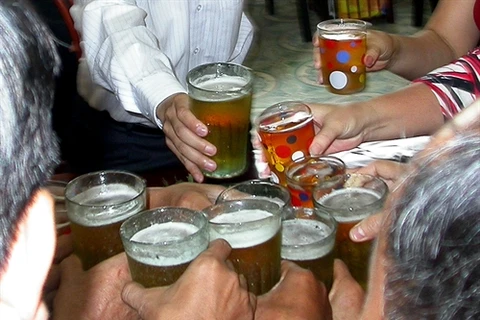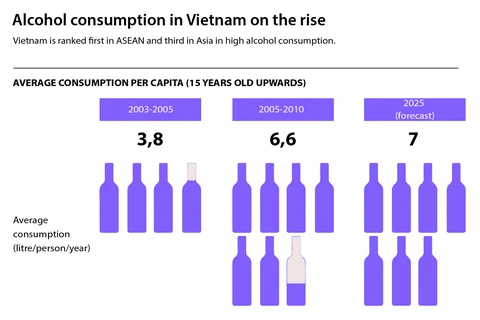 Doctors at the Bach Mai Hospital’s Poison Control Centre treat a victim of alcohol poisoning (Photo: dantri.com.vn)
Doctors at the Bach Mai Hospital’s Poison Control Centre treat a victim of alcohol poisoning (Photo: dantri.com.vn) Hanoi (VNA) – One thing that never fails to accompany the coming of Tet holidays is the repetitive drone of dire warnings about the risks of alcohol consumption.
Another thing that always seems to happen is that these dire warnings fall on deaf ears.
Early last week, a 39-year-old man living in Hanoi’s Tay Ho district was admitted to the Poison Control Centre (PCC) of the Bach Mai Hospital in a critical condition.
His condition was suspected to be a result of excessive drinking. Two days earlier, the patient had exhibited signs of fatigue and later fell into a deep coma, with dilated pupils.
His relatives thought he’d suffered a stroke and rushed him to the Hanoi Heart Hospital, but he was transferred later to the PCC following a methanol poisoning diagnosis.
A month earlier, the centre had received another man, 47, from Hanoi’s Thach That district, with hazy vision, headaches and severely impaired cognitive functions following intensive ‘binge drinking’ for three to four days, and years of alcoholism.
Test results showed that the methanol level in his blood had reached 300mg/100ml.
The doctors tried their best, administering detoxification drugs and using a pacemaker, but the main died.
Doctors and experts say a distinction must be made between methanol in spurious liquor, versus ethanol in legally produced liquor.
Legal alcoholic drinks are made with ethanol, and are quite safe to consume in moderation.
However, in Vietnam, it is not always easy to differentiate between fake and genuine liquor, because fakes of famous brands are immensely profitable, and in widespread use despite the risk of toxic substances being used in place of ethanol. Experts say that methanol – the simplest form of alcohol that can only be used legally for industrial purposes, for example, as antifreeze and fuel – is most often used in place ethanol in fake liquor, although its use for human consumption is expressly prohibited.
Nguyen Trung Nguyen, Director of the PCC, said that in the lead up to important holidays or celebrations, especially the New Year and Lunar New Year, at least one victim of alcohol poisoning is admitted to the centre every day. The rate is two to three times higher than normal during the holidays, he said.
On ‘rush’ days, doctors have to handle four to five emergencies related to alcohol poisoning.
According to the Ministry of Health, the previous Lunar New Year holiday witnessed some 2,000 cases of alcohol poisoning.
Alcohol hits the central nervous system directly, thus, nearly all the victims displayed the same set of symptoms.
However, methanol poisoning also leads to uncontrollable vomiting, lack of response to vocal calls, shaking or pinching, inability to sit up straight – and in more extreme cases like the patient above, deep coma.
Dr Tran Hung of the PCC said it was difficult to know whether someone was suffering from alcoholic poisoning or just being drunk.
Family members of those poisoned typically think that their relatives are just tired from drinking and that some rest will return them to normal. However, if the patient is suffering from alcohol poisoning, the intoxication will result in hypoglycaemia - a precipitous drop in blood sugar/glucose – followed by unconsciousness, and each passing moment makes full recovery less likely.
Nguyen also expressed deep concern over the fact that alcohol consumers are getting progressively younger.
“As far as I know, the large majority of drinkers used to be adults, middle-aged, but drinking liquor is now widely prevalent among young adults, including undergraduates,” he said.
Medically speaking, Nguyen said, liquor “acts like sleeping pills” thanks to its muscle relaxant and sedative properties.
Of course, this soporific effect will be particularly dangerous if the drinkers have to drive, or even stay outside.
If the alcohol concentration in blood reaches 50 mcg/dcl, the ability of the drinker to make judgement calls is negatively affected, motor skills are impaired, five senses dulled, speech slurred.
Nguyen also said that excessive consumption of alcohol is often accompanied by aggressiveness.
With slowed down mental processes, physical injuries are bound to ensue, in addition to digestive disorders, said Hoang Bui Hai, Head of the Department of Emergency and Intensive care, under the Hanoi Medical University Hospital. He said ‘social drinking’ can “easily” turn into full-blown alcohol abuse.
The number of alcohol poisoning cases is on the rise due to a pronounced upswing in people’s alcohol consumption, especially of dubious quality, experts say.
Nguyen Hung Long, Deputy Director of the Vietnam Food Administration under the Ministry of Health, said that the production and selling of fake liquor made with methanol is quite common.
In addition the trend of consuming homemade ruou ngam (rice wine) is also on the rise. This liquor comes with many “medicinal” properties when made with fruits and herbs or infused with snakes, seahorses, monitor lizards and other creatures.
However, people take the ‘anything goes’ approach a bit too far, and take word of mouth propaganda too seriously, resulting in haphazard use of random plants and animals and insects found in the forests without knowledge of their properties. The results can be tragic, sometimes.
With demand for alcoholic drinks soaring during the Tet holiday, the market surveillance departments are ill-equipped to inspect all the shops and stores in a city, and the fake products are increasingly difficult to spot.
Officials have called on consumers to be more aware and very careful in buying liquor, sticking to prestigious brands of clear origins with genuine anti-counterfeit tags and labels.
According to the General Department of Preventive Medicine under the Ministry of Health, the body can only metabolise beer and alcohol in little amounts – 10 grams of alcohol, equivalent to a small glass of wine or cup of beer – in one hour.
Consuming beyond this level can cause toxins in alcoholic drinks to accumulate in the liver, poisoning the whole body.
In addition, excessive drinking is the direct cause of at least 30 types of cancer, and the risk of cancer grows exponentially with every additional glass of beer or liquor.
Dr. Tran Quoc Bao from the General Department of Preventive Medicine, said Vietnamese citizens consumed a total of 3.4 billion litres of beer and 70 million litres of hard liquor last year.
The consumption of another 200 million litres of homemade liquor of dubious origins poses elevated health risks, he said.
Alarmingly, an adult male consumes some 27.4 litres of pure alcohol every year.
Nguyen Phuong Nam, a representative of World Health Organisation in Vietnam, said the country currently ranks second in Southeast Asia, 10th in Asia, and 29th in the world in alcohol consumption.
44.2 percent of drinkers consume at a “dangerous to health” level while 45 percent of drinkers drive within two hours after alcohol consumption.-VNA
VNA






















